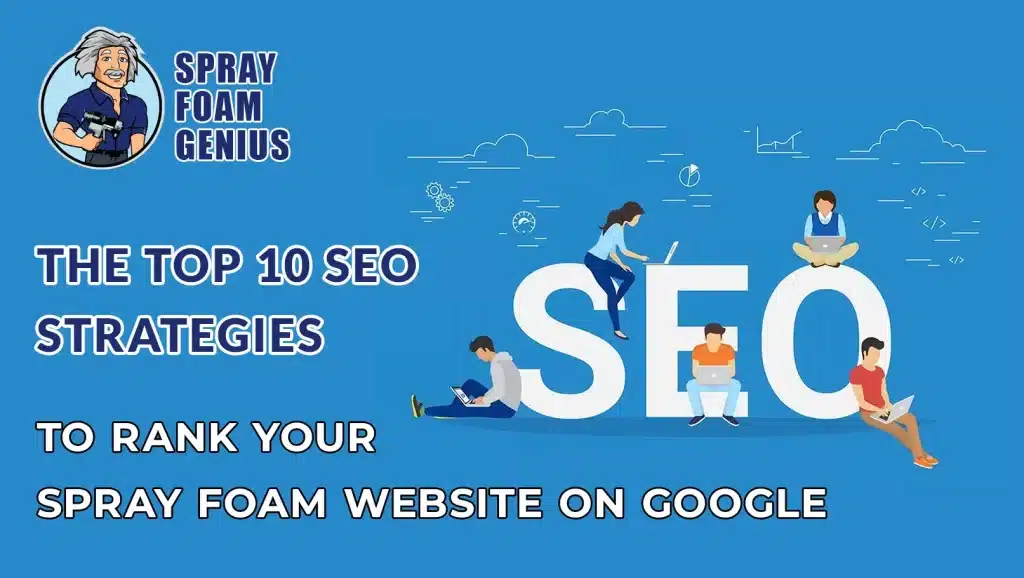
If you’re running a spray foam insulation business, you already know how competitive things are getting—especially online. These days, when someone needs insulation, their first stop is Google. If your website doesn’t show up when they search, you’re handing that job to another contractor.
Good SEO (Search Engine Optimization) helps you show up where it matters—on the first page of search results. More visibility means more phone calls, more quote requests, and more jobs.
Let’s dive into 10 specific SEO strategies designed to help spray foam contractors get better rankings and more leads from Google.
Why SEO Matters for Spray Foam Contractors
Homeowners and builders aren’t flipping through the Yellow Pages anymore. They’re Googling things like “spray foam insulation near me” or “best insulation for metal buildings.” If you’re not showing up, they’re not calling you.
And here’s a stat that drives it home: 75% of people never scroll past the first page of search results.
Ranking well means your business becomes the top choice, not just one of many. SEO isn’t optional anymore—it’s essential if you want to grow in today’s market.
Strategy #1: Optimize for Local SEO

Start with your Google Business Profile. It’s free and incredibly powerful.
Make sure your:
- Name
- Address
- Phone number
…are exactly the same across your website, profile, and directories. That consistency builds trust with Google.
Also:
- Add photos of real jobs you’ve done
- Ask happy customers to leave reviews
- List your services clearly (e.g. attic insulation, crawl space, metal buildings)
Strategy #2: Use High-Intent Spray Foam Keywords
You want to show up when people are ready to buy, not just browsing.
Some solid keyword examples:
- “spray foam insulation cost in [city]”
- “garage spray foam insulation near me”
- “closed cell insulation contractor [city]”
Use tools like Ubersuggest or Google’s Keyword Planner to find what people in your area are searching for. Then, naturally include those phrases on your pages—especially in titles and headlines.
Strategy #3: Create Landing Pages for Each City or Area
If you serve multiple towns or regions, don’t try to cram them all into one page. Instead, build separate service pages for each area.
For example:
- /spray-foam-insulation-austin
- /spray-foam-insulation-round-rock
Each should mention specific neighborhoods, zip codes, or local landmarks. Add photos from jobs you’ve done in the area—it builds trust and helps SEO.
Strategy #4: Get Listed on Trusted Directories
Google looks at how often your business appears online. More listings = more authority.
Start with:
- SprayFoam.com
- Angi
- Yelp
- Houzz
- HomeAdvisor
Just make sure your contact info is identical on every listing. Small differences (like “Street” vs. “St.”) can hurt your local SEO.
Strategy #5: Make Your Website Fast and Mobile-Friendly
If your site takes too long to load or doesn’t work on a phone, people will leave. Google notices that and pushes you down the rankings.
What to fix:
- Compress images so they load faster
- Use a mobile-responsive layout
- Clean up clutter (pop-ups, too many animations)
- Run a free check with PageSpeed Insights
Strategy #6: Use Local Schema Markup
Schema is code that helps Google understand your content. You don’t see it, but it works behind the scenes.
For spray foam businesses, use:
- Local Business schema
- Review schema
- Service schema
It can help you show star ratings in search and stand out from competitors.
Strategy #7: Get Real Backlinks from Industry and Local Sources
Think of backlinks as referrals. When trusted websites link to yours, Google takes it as a sign you’re legit.
Try to get links from:
- Spray foam equipment suppliers
- Contractor directories
- Local business partnerships
- Guest blogs on insulation or construction websites
One or two high-quality links can move the needle more than dozens of random ones.
Strategy #8: Write Blog Posts That Show Real-World Experience
Google favors content that shows experience and trustworthiness—especially for local service businesses.
Here are some blog ideas:
- “Should I Insulate My Pole Barn with Spray Foam?”
- “What’s the Difference Between Open Cell and Closed Cell?”
- “How We Helped a Homeowner Cut Energy Bills by 40% in [City]”
Write like you’re talking to a homeowner who’s never heard of spray foam. That kind of honest, helpful content works.
Strategy #9: Use Internal Links to Guide Visitors
Your blog, service pages, and home page should all connect to each other. If someone lands on a blog, guide them to your estimate page. If they’re on a service area page, send them to a project gallery.
This helps visitors stay on your site longer—and helps Google figure out which pages are most important.
[Image: On-page SEO checklist on a contractor’s service page]
Strategy #10: Keep an Eye on Your SEO Performance
You won’t know what’s working unless you track it.
Use:
- Google Search Console to monitor keywords and indexing
- Google Analytics to see where traffic comes from
- A basic rank tracker to see if your rankings go up or down
Check your numbers every month. See what’s improving, what’s dropping, and tweak your content accordingly.
Organic vs. Paid Traffic ROI
| Factor | Organic (SEO) | Paid (Google Ads) |
| Long-term visibility | ✅ Yes | ❌ Stops when budget ends |
| Trust factor | ✅ Higher (not marked as ads) | ❌ Lower (clearly marked) |
| Cost over time | ✅ Decreases | ❌ Constant spend |
| Setup time | ❌ Slower build-up | ✅ Instant traffic |
Things to Avoid When Doing SEO for Your Spray Foam Website
- Copying content from competitors or your own location pages
- Using “insulation” keywords that don’t mention spray foam
- Paying for low-quality backlinks
- Ignoring technical issues like broken links
- Overusing keywords (it makes your writing awkward)
Ready to Rank Higher and Get More Leads?
SEO isn’t a quick fix—but if you’re consistent, the results stick. These strategies can help you get more visibility in your service area, bring in more qualified leads, and build a reputation as the go-to insulation expert in your market.
If you’re ready to take the next step, here’s how to connect:
Spray Foam Genius Marketing
📞 USA: 877-840-FOAM
📞 Canada: 844-741-FOAM
📧 [email protected]
🌐 Visit Website
FAQs
1. What keywords should spray foam contractors use?
Focus on local search terms that match what your customers are typing in, like “spray foam insulation in [city]” or “garage foam insulation cost.”
2. How long does SEO take to work?
Usually, you’ll see movement in 3–6 months, but it depends on your competition and how aggressive your strategy is.
3. Do I need a blog on my website?
Yes, blogging helps you rank for more keywords and builds trust with homeowners who are researching insulation options.
4. Can I just use Google Ads instead?
Google Ads can bring quick leads, but SEO builds long-term traffic that doesn’t stop when your budget does.
5. How do I show up in the local map results?
Make sure your Google Business Profile is fully filled out, get reviews, and use consistent business info across the web.
6. Should I create separate pages for each city I serve?
Absolutely. It helps you rank better in those specific locations—and customers trust businesses that feel local.
7. What’s the biggest mistake people make with SEO?
Trying to game the system—stuffing keywords, buying bad backlinks, or using duplicated pages. Google sees through it.
8. Do backlinks really help with local SEO?
Yes, especially if they come from trusted sources in your industry or area.
9. How often should I update my site’s content?
Every 6–12 months is a good rule. Refresh pages that aren’t ranking or have outdated info.
10. Can I do SEO myself?
You can handle some basics yourself—but if you’re too busy spraying foam, hiring someone who knows the ropes will save you time and bring faster results.
Spencer is a Google ranking expert and SEO consultant who has helped businesses in the spray foam marketing industry achieve their online marketing goals. Spray Foam Genius Marketing has a proven track record of success, having achieved some impressive results for his clients.

